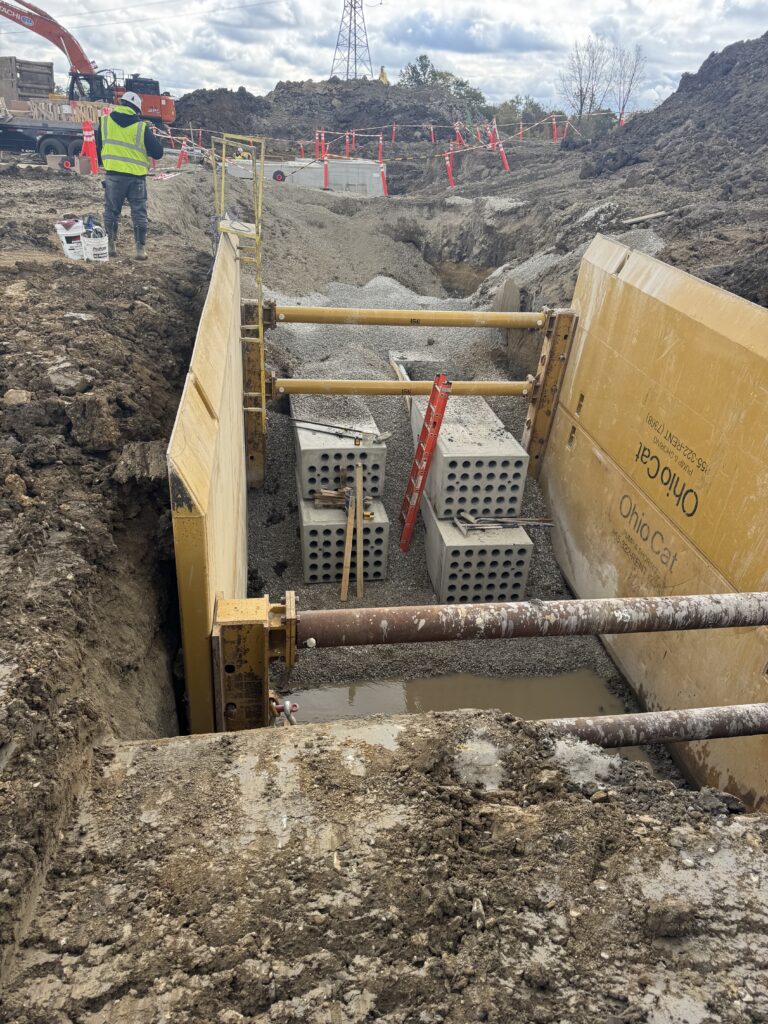General contractors carry the risk no one else can — safety, schedule, and subcontractor coordination. When duct bank work slips, so does every trade behind it. That’s why GCs have been some of the fastest adopters of DBO’s precast duct bank system. It doesn’t just improve the electrical scope; it improves the entire job.
Prefab Performance That Matches GC KPIs
Large builders measure success with a few key indicators:
- Safety incidents
- Schedule adherence
- Productivity per crew hour
- Rework percentage
- Prefab and modular utilization
DBO’s process directly impacts all five.
| KPI | Traditional Duct Bank | With DBO Precast |
| Safety | 10–15 workers in the trench for several days | 2–3 surface-level operators; same-day backfill |
| Schedule | 3–5 days per run (weather dependent) | 1 shift from dig to backfill |
| Productivity | 50–100 ft/day | 400–600 ft/day |
| Rework | Frequent alignment or over-pour issues | Factory-verified, zero re-pour |
| Prefab/Modular Compliance | Low | High — off-site fabrication and traceability |
By shifting critical-path work off-site, DBO helps GCs hit their prefab and modular utilization targets while reducing site congestion and risk.
Safety and Risk: Controlled by Design
Every safety director knows that the riskiest time on a site is when the trench is open.
Cast-in-place duct banks keep crews there for days — tying rebar, setting conduit, pouring, finishing, curing.
DBO’s guided dowel-pin system eliminates all of that:
- Operators set each section to within 18 inches of grade.
- Dowel pins align the joint automatically.
- No hands in the trench. No pry bars. No finish work.
Trenches are open for hours, not days. GCs see the result on every safety report: fewer trench entries, fewer exposure hours, fewer recordables.
Simplified Logistics = Faster Turnover
Ask any superintendent — managing trench logistics is one of the toughest coordination challenges on a jobsite. Cast-in-place means trucks, mixers, rebar cages, inspectors, and multiple trades stacked in the same lane.
DBO’s process simplifies it down to three steps:
- Excavate and prep.
- Set the precast sections.
- Backfill and release.
No concrete trucks. No field curing. No rebar tying. That efficiency frees up space and time for other trades — especially underground utilities, paving, and structural.
On recent large-scale projects, general contractors using DBO reported underground completion 30–40% faster than baseline schedules and zero trench conflicts between electrical and civil teams.
Real Project Results
On a hyperscale campus in the Midwest, duct banks were originally scheduled for a three-week installation per corridor. Using DBO’s precast system, the GC’s team closed the same trench in under a week — despite multiple rain delays.
A second project in the Southwest hit the same milestone: the duct bank install finished early, which allowed grading and paving crews to start 10 days ahead of plan. No safety incidents. No inspection rework. No lost time.
Why GCs Keep Coming Back
Every contractor who’s run DBO once calls again on the next project — not because of the product alone, but because of the predictability.
They know:
- The duct bank scope won’t hold up other trades.
- Their electrical subcontractors will hit bid-hour efficiency.
- Safety and prefab metrics will move in the right direction.
- The schedule will stay under their control.
For GCs managing complex builds, DBO isn’t just a material vendor — it’s a way to de-risk the entire underground scope.
Build the Job That Finishes On Time
When safety, prefab, and schedule all align, projects move the way they should. That’s why GCs who have experienced DBO’s process once now specify it up front. Because hitting your KPIs isn’t luck — it’s process. And DBO has already built it.



